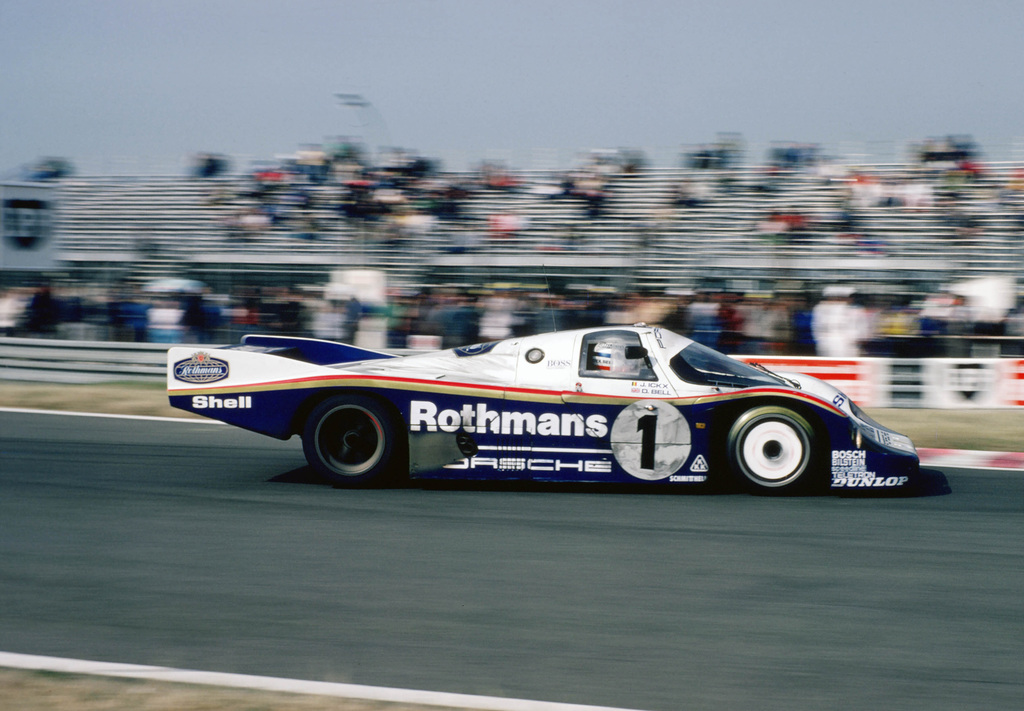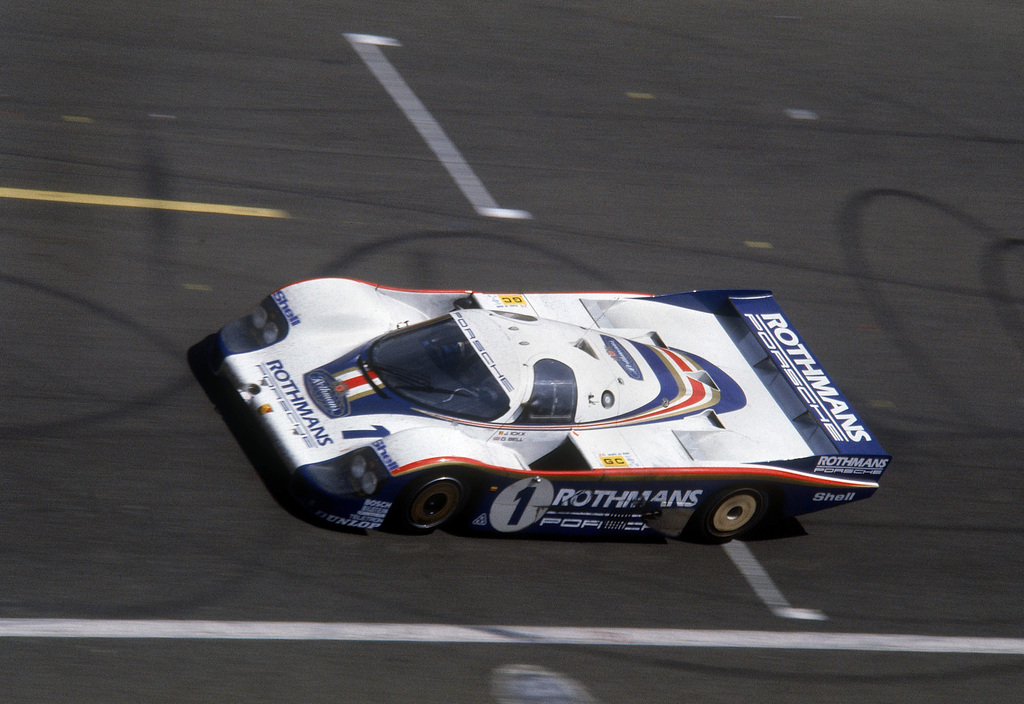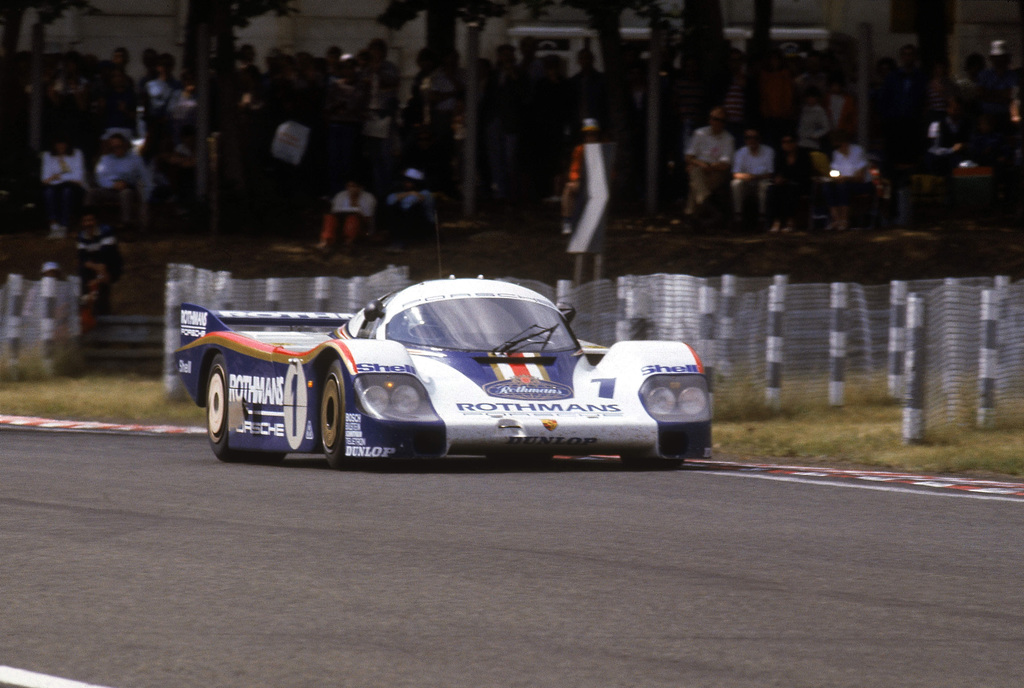Porsche 956 (1982 – 1983)
Premiere: 1982 May 15 at Silverstone / Achievements: Le Mans winner 1982 – 1983
To correspond with Group C racing first introduced by the FIA, Porsche designed the 956. Their program, led experienced project manager Norbert Singer, placed strong emphasis on winning the 1982 Le Mans. That year, Porsche made a clean sweep; first second and third was theirs. The lack of any real competition in 1982 practically handed them the championship, but due to their tremendous team, and the newly developed Weissach facility, Porsche turned the 956 into a customer prototype that would rule motorsport for a decade.
FIA had announced new racing classes in time for the 1982 season. Group A was meant for cars that were built from 4-seater mass-produced cars (production capacity at least 5000 units a year). Group B was for heavily modified cars and saw some of the greatest rally cars ever created. Group C was the new class for the prototype sports cars. Group C cars were allowed a minimum weight of 800 kg and a race average fuel consumption of up to 60 L/100 km. Because of the fuel consumption limit the power of the cars was in the 600 hp region.
The 956 was later upgraded to the Porsche 956B in 1984. In this post we focus on the 956 of 1982 and 1983.
Porsche 956 Development
With the rules on his desk in Porsche’s research and development center in Weissach, racing engineer Norbert Singer put his team to work in June 1981 to create the first Porsche with ground-effect aerodynamics. Norbert Singer is the only person who has belonged to all Porsche teams that have won the Le Mans 24H race between 1970 and 1998.
The regulations stipulated the proportion of overall length to the wheelbase, to avoid excessive long tail constructions. Porsche team decided on a wheelbase measuring 2650 mm (+350 mm compared to the 917). In August 1981 Singer’s team works with the first 1:5 model in the wind tunnel. As a new advantage they were to exploit the ground-effect known from Formula 1 cars. The shape of the underbody and the sidepods generated an underpressure which sucked the car to the track surface. The 956 was also the first Porsche to feature an aluminium monocoque chassis which is 80% stiffer than was the frame of the 936. As the power was restricted by the fuel consumption, there was no need for the new engine. The 2.65-litre twin-turbo seen in the 1981 Le Mans-winning 936 would work well. Everything else on the vehicle was new, including the gearbox.

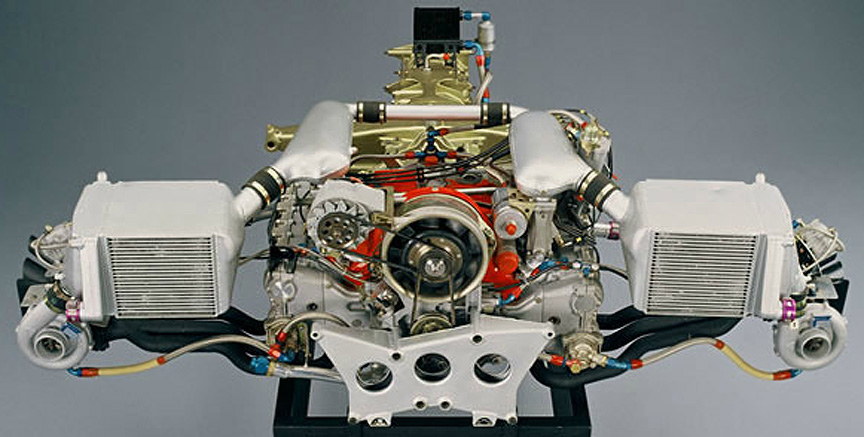

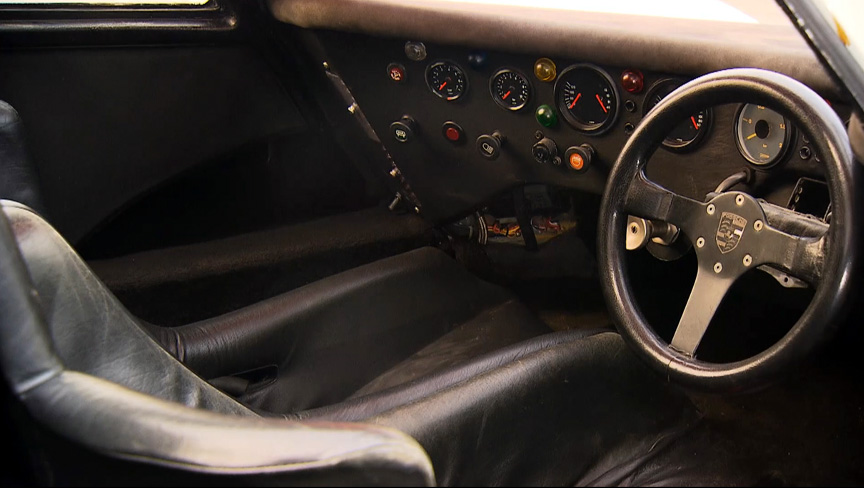
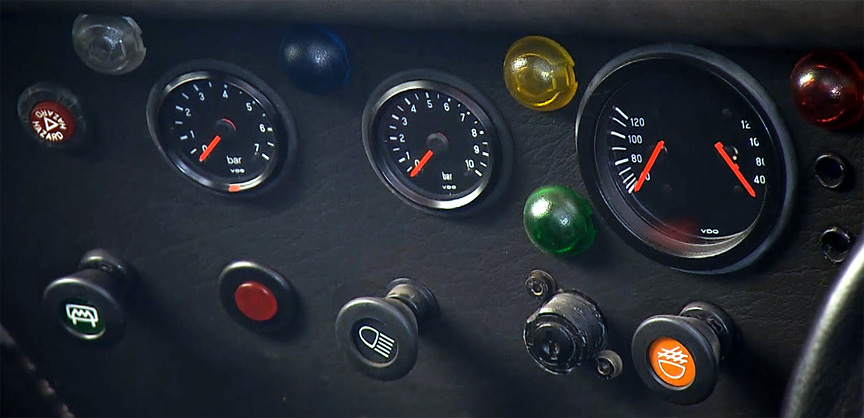

On March 27, 1982, Jürgen Barth, the leader of Porsche racing department, takes the revolutionary 956 (chassis 001) to the Weissach test track for the first time. Although F1-type lateral skirts that completely prevented air from flowing in from the sides were not allowed for Group C vehicles, the 956 still realised cornering speeds previously thought impossible for racing sports cars.
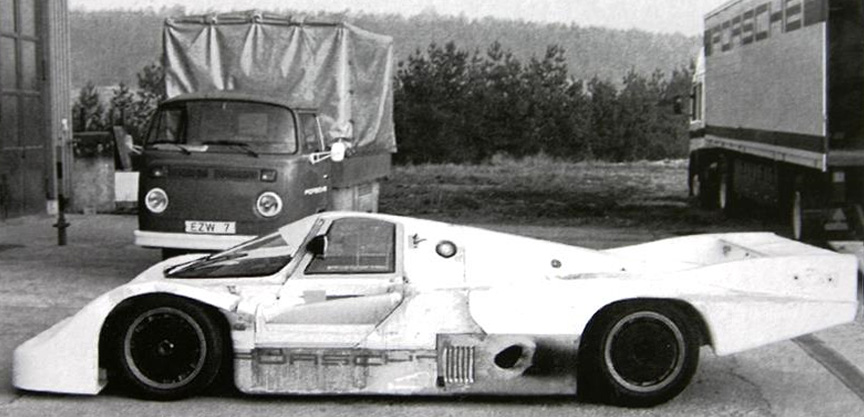
The Porsche 956 Basics
| Engine | 2.65 L F6 twin-turbo, 4 valves per cylinder, water-cooled cylinder heads, air-cooled cylinders |
| Weight | 820-855 kg / 1800-1900 lb |
| Fuel tank | 99 L (allowed size 100 L) |
| Dimensions | length 4800 mm, wheelbase 2650 mm (allowed length tied to wheelbase), width 2000 mm (allowed maximum) |
| Top speed | 218+ mph/350+ km/h |
| Production | 25 (28 numbered chassis built, but some used to rebuild crashed cars). Includes 956 and 956B. |
Type 935/76 (1982) Engine
| Displacement | 2.65 litre (2649 cc) |
| Horsepower | 620 bhp @ 8200 rpm; 1.2 bar boost (standard boost) |
| Torque | 465 ft lbs |
| Turbochargers | Twin turbo KKK K26 |
| Cooling | Water-cooled cylinder heads, air-cooled cylinders with fan |
| Fuel feed | Kugelfischer mechanical injection |
Porsche 956 & Racing
The 956 wasn’t sorted yet for the first round of the World Sportscar Championship at Monza in April and was entered a month later for the 6 hour race at Silverstone. Porsche drivers Jacky Ickx/Derek Bell scored second. The next race, the Nürburgring 1000 km was skipped again in the favour of sorting out the car for the next and most important race of the year – the 24 hour race of Le Mans.
For the 1982 Le Mans 24H race the factory team fielded three 956, which… all finished on podium! More to that – the cars finished exactly as were their racing numbers. The winning car #1 was driven by Jacky Ickx/Derek Bell, the second place car #2 was driven by Jochen Mass/Vern Schuppan (3 laps behind the winner) and the last factory entered car #3 scored third driven by Al Holbert/Hurley Haywood/Jürgen Barth (19 laps from winner). The winning 956 averaged 127 mph/205 km/h and had a fuel consumption of 48 litres per 100 km.

The podium 956s were followed by two 935s. The race analysis showed that thanks to the sophisticated aerodynamics, the new-comer used considerably less fuel at higher average speeds than the 936. The triumph of a new idea and first place in all classes make June 20, 1982, a very special day in the history of Porsche.
Following the triumph at Le Mans, the victorious success continued: Norisring 200 miles, Spa 1000 km, Fuji 6 hours, Brands Hatch 1000 km, Kyalami 9 hours to name only the 1st place results. The 1982 World Sportscar Championship was won in the manufacturers category by Porsche and in the drivers category by Jacky Ickx.
Porsche makes the 956 available for customer teams for 1983. While the factory team cars had chassis numbers in the form of 9560xx, the customer cars had 9561xx for 1983 and 956B1xx for 1984 cars.
A day before the 1983 Nürburgring 1000 km race, on May 28, Stefan Bellof drove at record speed in the qualification covering the 20.832 km Nordschleife in only 6:11,13. This translates to 125 mph/202 km/h average speed. A record to break for the future drivers in their future machines.
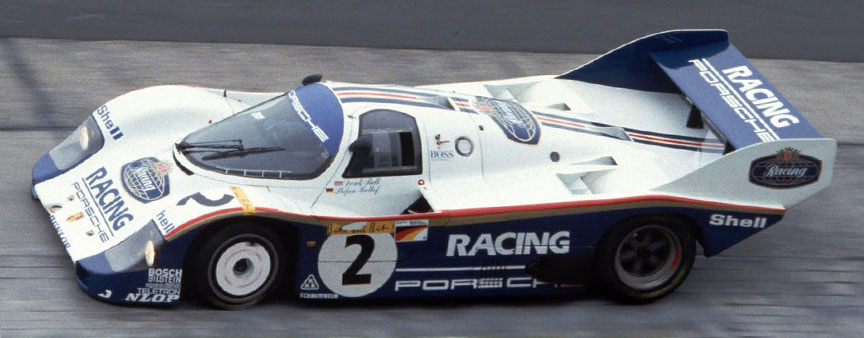
Bellof’s best lap in the race was 6:22 until his 956 (chassis number 956-007) went airborne at Pflantzgarten II, taking the leader out of the race.

Like the year before, tobacco sponsored Porsche factory team entered three 956 for the 1983 Le Mans 24H. In addition to the factory cars, private ones were entered with the total of eleven 956.
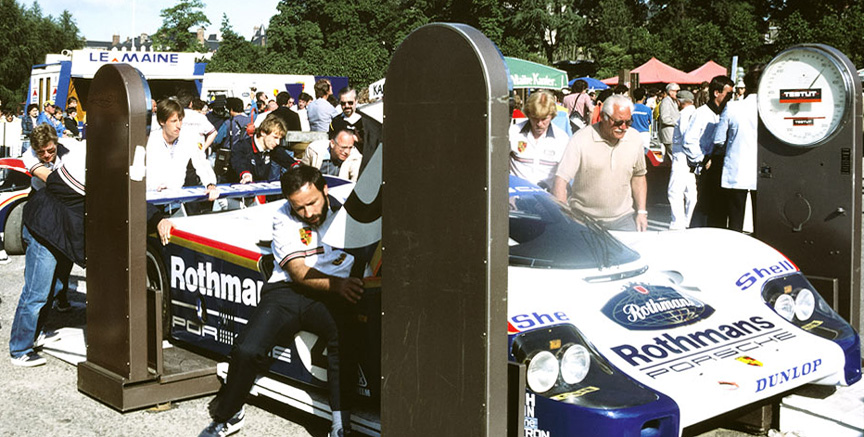
The factory team car #2 of Jochen Mass/Stefan Bellof had to retire the race because of an engine problem. The #3 car faced a nail-biting situation on Sunday afternoon. Leader Vern Schuppan lost a door at Mulsanne straight. A year before Al Holbert had accidentally pulled the wrong lever and lost the door, but now the aerodynamic forces ripped it away at top speed. A replacement door installed at the pits didn’t fit correctly and caused disruption of the air flow to one of the radiators which caused the temperature to rise to an unhealthy level.
After a battle with 25 changes at the top in 24 hours, Al Holbert/Hurley Haywood/Vern Schuppan still managed to take the victory. It was a close call as the engine was damaged and seized on the final lap. It did come to life for the short distance and Holbert managed to salvage the close victory in a heavily smoking car in front of chasing Bell. The engineers all agreed, the winning 956 would not have survived another lap. The #1 956 driven by Jacky Ickx/Derek Bell scored second. First eight places were captured by 956s and one more 956 took 10th place. The PCNA’s poster later said “Nobody’s perfect”.



An interesting fact in the history of the 956 is that in 1983 the Porsche-developed TAG-Turbo F1 engine was tested inside the 956 before it was tested in the McLaren F1 car. By the end of the season, Porsche again won the World Endurance Championship, Jacky Ickx secured his second consecutive world championship title. To name some of the 1983 race victories in addition to Le Mans: Suzuka 500 km, Monza 1000 km, Silverstone 1000 km, Nürburgring 1000 km, Fuji 500 km, Norisring 200 miles, Fuji 1000 km, Suzuka 1000 km, Spa 1000 km, Brands Hatch 1000 km, Fuji 1000 km, Mugello 1000 km, Kyalami 1000 km…
Although the 956 got a new fully synchromesh 5-speed manual gearbox, the semi-automatic gearbox was also on the drawing board. As early as 1964, Porsche had worked on a power shift dual clutch gearbox. In 1968 followed experiments with an automatic four-speed gearbox following the dual-clutch principle. Starting in 1979, various versions of dual-clutch gearboxes were designed. On this basis, the Porsche Doppelkupplungsgetriebe (PDK) was created in 1981. Developed for various purposes, it was tested between 1981 and 1986 in Porsche production cars (incl. 944 Turbo) in parallel to the Group C Porsche 956 racing sports car (as a semi and fully automatic version). Gear shifting without interruption in propulsive power proved particularly interesting for the turbocharged engines, as the turbo boost would not drop during the gear change. The 956-003 was the first race car to feature PDK for a test run in 1983.

In 1983 FIA had announced a new rule for the coming 1984 season – maximum allowed average fuel consumption of 51 L/100 km instead of earlier 60 L/100 km. As a result Porsche created the 956 B with Bosch electronic fuel injection.
In 1983 FIA had announced a new rule for the coming 1984 season – maximum allowed average fuel consumption of 51 L/100 km instead of earlier 60 L/100 km. As a result Porsche created the 956 B with Bosch electronic fuel injection. Then, in March 1984, three months before the Le Mans race, the new fuel consumption rule was discarded. This was an insult to Porsche – a lot of work was done over the year for nothing. In protest against the short-notice rule change concerning fuel consumption and weight, the factory team boycoted the race. Fourteen (!) 956s were entered by private racing teams and the result list was almost like the year before – first seven places went to 956.
The race was won by New-Man sponsored Joest Racing 956 #7 driven by Henri Pescarolo/Klaus Ludwig. Both men had won the race already before (now Pescarolo’s fourth victory and Ludwig’s second). For the 1984 season Porsche had also created a version of the 956 for the American market, called the 962. The IMSA rules demanded a safer cockpit for the driver and didn’t allow more than one turbo. Two private 962s were entered for Le Mans, one belonging to the Swap Shop sponsored team and the other to Skoal Bandit team. Unfortunately the Swap Shop car with the single K36 turbocharger had to retire because of the ignition system failure and the other 962-chassis car because of an accident. Luckily both racing teams had 956s, too, that would finish on podium.
Read more about the Porsche 956B


